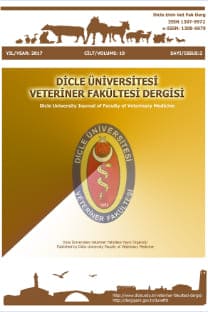Ruminantlarda Önemli Bir Komplikasyon: Ensizyonel Fıtıklar
Ensizyonel fıtık, şirürjikal olarak kapatılan operasyon bölgesinde, açılmaya bağlı olarak meydana gelen bir komplikasyondur. Özellikle operasyonlarda asepsi antisepsi kurallarına yeterli düzeyde riayet edilmemesi, postoperatif bakımın yetersiz olması, uygun dikiş materyallerinin ve yöntemlerinin uygulanmaması, hayvanın büyüklüğü sebebiyle intraabdominal basıncın fazla olması ensizyonel fıtık oluşumuna predispozisyon oluşturur. Bu çalışmanın amacı postoperatif komplikasyon olarak karşımıza çıkan ensizyonel fıtıkların retrospektif olarak değerlendirilerek bu komplikasyonların önlenmesine yönelik bilgiler aktarmaktır. Çalışmanın materyalini 28 koyun ile 8 buzağı oluşturdu. Koyunlardaki ensizyonel fıtıkların bilimsel çalışma sırasında embriyo toplama amacıyla yapılan laparotomi sonrasında meydana geldiği, buzağılarda ise cerrahi kliniğe getirilen ve hikâyesinde en az bir defa göbek bölgesi lezyonlarından birine bağlı olarak yapılan operatif işlemler sonucu oluştuğu belirlendi. Koyunlarda teşhis edilen ensizyonel fıtıklar, çalışmanın devam etmesi ve kesime sevk edilecek olmasından dolayı herhangi bir müdahalede bulunulmadı. Buzağılarda ise tedavi edilebilen 6 tanesine ikinci bir operasyon yapıldı. Buzağılardan 2’sine ise erkek olması, yaş, kilo ve operasyon açıklığının büyük olması ve hayvan sahibinin isteği doğrultusunda herhangi bir işlem yapılmadı. Çalışmadaki hayvanların, alınan anamnez ve yapılan klinik muayene ve gözlemlerde ensizyonel fıtık oluşumunda yukarıda sayılan nedenlerden en az bir ya da daha fazlasının bulunduğu belirlendi. Elde edilen bulgular ışığında ensizyonel fıtıkların karşımıza sıklıkla çıktığını ancak bunları en aza indirgemek için gerekli olan asepsi antisepsi kurallarına her ne koşulda olursa olsun riayet edilmesi ve uygun dikiş materyallerinin kullanımına özen gösterilmesinin önemli olduğu sonucuna varıldı.
Anahtar Kelimeler:
Ensizyonel fıtık, Komplikasyon, Ruminant
An Important Complication in Ruminants: Incısıonal Hernias
Incisional hernia is a complication that due to the relation of operation opening site that has been closed surgically. Especially predisposed by inadequate operational asepsis and antisepsis conditions, inadequate postoperative care, inadequate suture materials and inappropriate suturing methods and excess limits of intraabdominal pressure. The aim of the study is to inform by evaluation and prevention of incisional hernias encountered with postoperative complications we have faced. Twenty-eight sheep and 8 calves were used as material in this study. Incisional hernias in sheep occurred after laparotomy for embryo harvesting in a scientific study and in calves which have umbilical surgery history in their records. All sheep were approximately 3 years of age and calves were 5,5 months of age. Incisional hernias that have been diagnosed on sheep have not been treated because of the process of the study and they will be urged to the slaughter once the operation is concluded. But on the calves, they are treated due to recurrence or leakage and bulging complaints after operation and taken into second operation on 6 of the patients which are deemed as treatable. But for the two of calves, they were not done any process due to request of the owner and large opening on operation site along with increased age and weight. There are at least one or more reasons mentioned above have been found on all subjects in the study and examinations of incisional hernias in our cases. According to the examined findings it can be said that the fact of asepsis and antisepsis conditions should be strictly performed by the rules no matter the operation conditions are, and also attention must be paid on appropriate suture materials and techniques.
Keywords:
Complication Incisional hernia, Ruminant.,
- ISSN: 1307-9972
- Yayın Aralığı: Yılda 2 Sayı
- Başlangıç: 2008
- Yayıncı: Dicle Üniversitesi Veteriner Fakültesi
Sayıdaki Diğer Makaleler
Kör Fare (Spalax ehrenbergi, Nehring, 1898) Kolonunda MUC1, MUC2 ve MUC5AC’nin Dağılımı
M. Aydın KETANİ, Zelal KARAKOÇ, Şennur KETANİ
Deneysel Diyabet Oluşturulan Sıçanlarda Böbreklerin Histolojik Olarak Değerlendirilmesi
M. Aydın KETANİ, Berfin KADİROĞLU, Zelal KARAKOÇ
Ruminantlarda Önemli Bir Komplikasyon: Ensizyonel Fıtıklar
